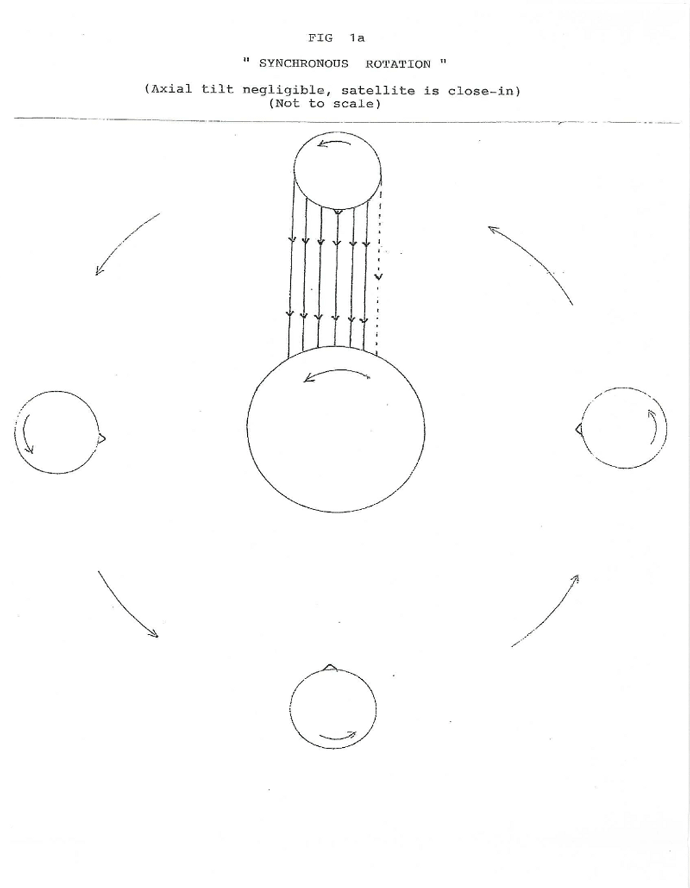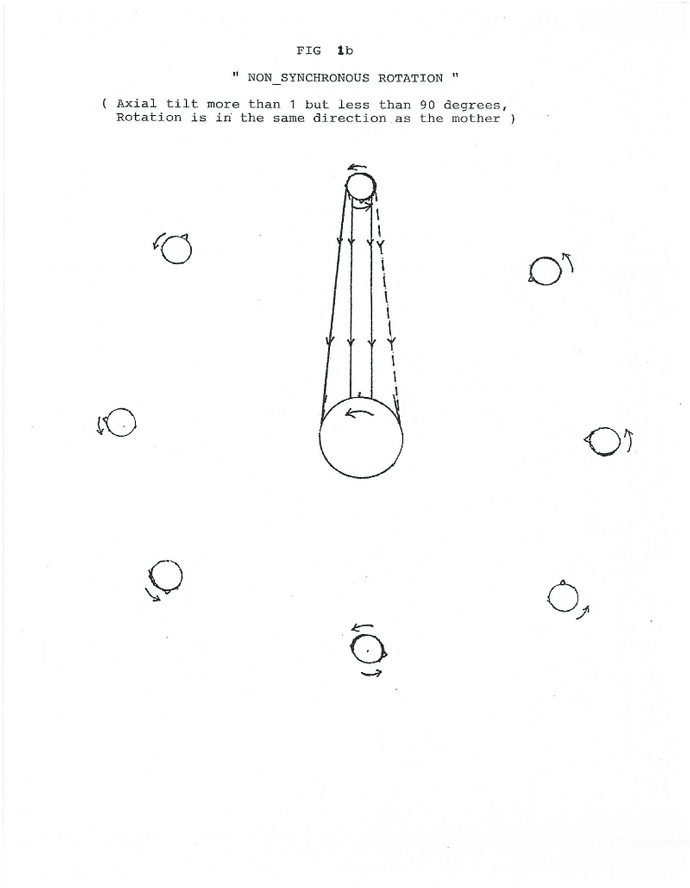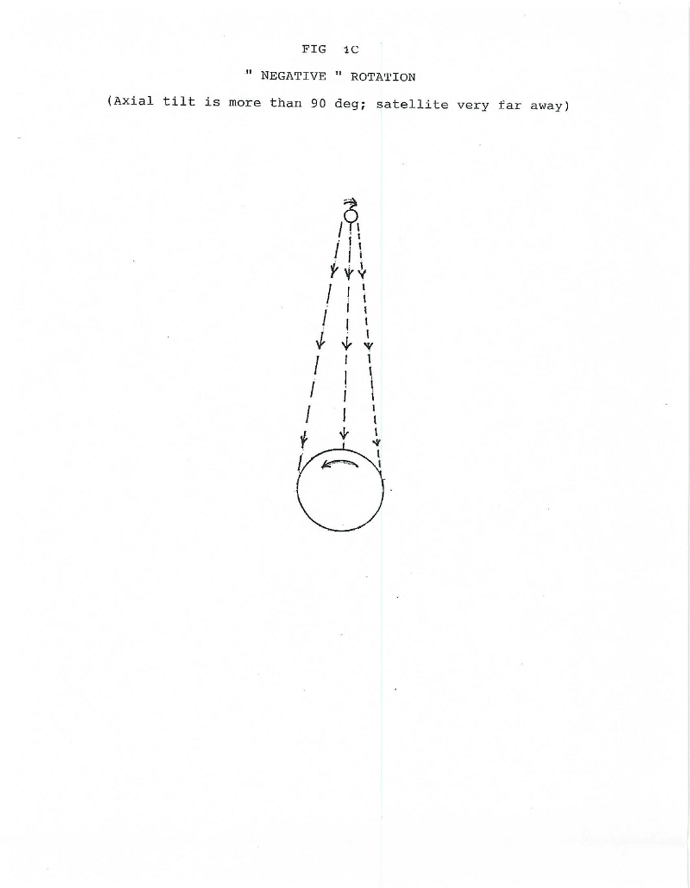Tables & Figures
TABLE l
PLANETARY FACT SHEET - METRIC
|
Mercury |
Venus |
Earth |
Mars |
Jupiter |
Saturn |
Uranus |
Neptune |
Pluto |
Mass (1024Kg)
|
0.330
|
4.87 |
5.97 |
0.642 |
1,899 |
568 |
86.8 |
102 |
0.0125 |
Diameter (Km) |
4,879 |
12,104 |
12,756 |
6,792 |
142,984 |
120,536 |
51,118 |
49,528 |
2,390 |
Density (Kg/m3) |
5,427 |
5,243 |
5,515 |
3,933 |
1,326 |
687 |
1,270 |
1,638 |
1,750 |
Gravity (m/s2) |
3.7 |
8.9 |
9.8 |
3.7 |
23.1 |
9 |
8.7 |
11 |
0.6 |
Distance From sun (106Km) |
57.9 |
108.2 |
149.6
|
227.9 |
778.6 |
1,433.5 |
2,872.5 |
4,495.1 |
5,870 |
Orbital Period (days) |
88 |
224.7 |
365.2 |
687 |
4,331 |
10,747 |
30,589 |
59,800 |
90,588 |
Orbital Velocity (km/sec) |
47.9 |
35 |
29.8 |
24.1 |
13.1 |
9.7 |
6.8 |
5.4 |
4.7 |
Axial Tilt (Degrees) |
0.01 |
177.4 |
23.4 |
25.2 |
3.1 |
26.7 |
97.8 |
28.3 |
122.5 |
Rotation Period (h) |
1,407.6 |
-5,832.5* |
23.9 |
24.6 |
9.9 |
10.7 |
-17.2* |
16.1 |
-153.3* |
Length of Day (h) |
4,222.6
|
2,802 |
24 |
24.7 |
9.9 |
10.7 |
17.2 |
16.1 |
153.3 |
Magnetic Field |
Yes |
No |
Yes |
No |
Yes |
Yes |
Yes |
Yes |
Unknown |
Perihelion (106Km) |
46 |
107.5 |
147.1 |
206.6 |
740.5 |
1,352.6 |
2,741.3 |
4,444.5 |
4,435 |
Aphelion (106Km) |
69.8 |
108.9 |
152.1 |
249.2 |
816.6 |
1,514.5 |
3,003.6 |
4,545.7 |
7,304.3 |
*Negative rotation means axial rotation opposite to that of the Sun
Adapted from: http://nssdc.gsfc.nasa.gov/planetary/factsheet/index.html
TABLE II A
COMPARISON OF PLANETS WITH NEGATIVE ROTATION
(VENUS, URANUS, AND PLUTO), TO EARTH AND JUPITER
|
|
Venus |
|
Uranus |
|
Pluto |
|
Earth |
|
Jupiter |
Mass (1024Kg) |
|
4.87 |
|
86.8 |
|
0.0125 |
|
5.97 |
|
1,899 |
Diameter (km) |
|
12,104 |
|
51,118 |
|
2,390 |
|
12,756 |
|
142,984 |
Rotation Period (hours) |
|
-5,832.5* |
|
-17.2* |
|
-153.3* |
|
23.9 |
|
9.9 |
Length of Day (hrs) |
|
2,802 |
|
17.2 |
|
153.3 |
|
24 |
|
9.9 |
Orbital Inclination (Degrees) |
|
3.4 |
|
0.8 |
|
17.2 |
|
0.0 |
|
1.3 |
Axial Tilt (Degrees) |
|
177.4 |
|
97.8 |
|
122.5 |
|
23.4 |
|
3.1 |
Magnetic Field |
|
No |
|
Yes |
|
Unknown |
|
Yes |
|
Yes |
*Negative rotation means axial rotation opposite to that of the Sun
Adapted from: http://nssdc.gsfc.nasa.gov/planetary/factsheet/index.html
TABLE II B
ROTATION PERIOD, AXIAL TILT AND ORBITAL PERIOD COMPARED WITH LENGTH OF DAY, IN MERCURY, VENUS AND EARTH
|
Mercury |
Venus |
Earth |
Rotation Period (Hours) |
1,407.6 |
-5,832.5* |
23.9 |
Length of Day (Hours) |
4,222.6 |
2,802 |
24 |
Axial Tilt (Degrees) |
0.01 |
177.4 |
23.4 |
Orbital Period (Days) |
88.0 |
224.7 |
365.2 |
*Negative Rotation (Venus) means axial rotation opposite in direction to the
Sun’s rotation.
Adapted from: http://nssdc.gsfc.nasa.gov/planetary/factsheet/index.html
TABLE III A
ORBITAL PARAMETERS OF SATELLITES OF JUPITER
Satellites: |
Radius (Km) |
Orbital Period (Days) |
Rotation Period (Days) |
Inclination (Degrees) |
A) Galilean: |
|
|
|
|
Io |
1,821.6 |
1.769138 |
S |
0.04 |
Europa |
1,560.8 |
3.551181 |
S |
0.47 |
Ganymede |
2,631.2 |
7.154553 |
S |
0.21 |
Callisto |
2,410.3 |
16.689018 |
S |
0.51 |
|
|
|
|
|
B) ‘Lesser’ |
|
|
|
|
Metis |
20 |
0.294779 |
S |
0.06 |
Adrastea |
13x10x8 |
0.298260 |
S |
0.03 |
Amalthea |
131x73x67 |
0.498179 |
S |
0.40 |
Thebe |
55x45 |
0.6745 |
ND |
0.8 |
Themisto |
4 |
132.02 |
ND |
45.67 |
Leda |
5 |
240.92 |
ND |
27.47 |
Himalia |
85 |
250.5662 |
0.4 |
27.63 |
Lysithea |
12 |
259.22 |
ND |
27.35 |
Elara |
40 |
259.6528 |
0.5 |
24.77 |
S/2000 J11 |
2 |
287.0 |
ND |
28.3 |
Euporie |
1 |
553.1 R |
ND |
147.0 |
Euanthe |
1.5 |
620.6 R |
ND |
148.9 |
Harpalyke |
2.2 |
623.3 R |
ND |
148.7 |
Praxidike |
3.4 |
625.3 R |
ND |
148.7 |
Orthosie |
1 |
622.6 R |
ND |
145.9 |
Iocaste |
2.6 |
631.5 R |
ND |
159.7 |
Ananke |
10 |
629.8 R |
ND |
148.9 |
Hermippe |
2 |
633.9 R |
ND |
150.7 |
Thyone |
2 |
627.3 R |
ND |
148.5 |
Arche |
1.5 |
723.9 R |
ND |
165.0 |
Pasithee |
1 |
716.3 R |
ND |
165.4 |
Kale |
1 |
729.5 R |
ND |
165.0 |
Chaldene |
1.9 |
723.8 R |
ND |
165.4 |
Isonoe |
1.9 |
725.5 R |
ND |
165.0 |
Eurydome |
1.5 |
717.3 R |
ND |
150.3 |
Erinome |
1.6 |
728.3 R |
ND |
164.9 |
Taygete |
2.5 |
732.2 R |
ND |
165.2 |
Carme |
15 |
734.2 R |
ND |
164.9 |
Kalyke |
2.6 |
743 R |
ND |
165.2 |
Aitne |
1.5 |
730.2 R |
ND |
165.1 |
Pasiphae |
18 |
743.6 R |
ND |
151.4 |
Megaclite |
2.7 |
752.8 R |
ND |
152.8 |
Sponde |
1 |
748.3 R |
ND |
151 |
Sinope |
14 |
758.9 R |
ND |
158.1 |
Callirrhoe |
4 |
758.8 R |
ND |
147.1 |
Autonce |
2 |
762.7 R |
ND |
152.9 |
C) Newly discovered satellites S/2003 J1 to S/2003 J23 all have orbital periods from 504 to 982.5; all exhibit reverse ‘motion’ and orbital inclination from 141 to 165
The sole exception is the following: Orbital Period (Days) Inclination (Degrees)
Carpo (S/2003 J20) 3 456.1 51.4 No retrograde motion
S=Synchronous rotation = (rotation period is the same as the orbital period)
R=Retrograde motion (orbit) ND=No data available
Adapted from: http://nssdc.gsfc.nasa.gov/planetary/factsheet/joviansatfact.html
TABLE III B
ORBITAL PARAMETERS OF SATELLITES OF SATURN
Satellites |
Radius (Km) |
Semimajor axis (103Km) |
Orbital Period (Days) |
Rotation Period (Days) |
Inclination (Degrees) |
A) Major: |
|
|
|
|
|
Mimas |
208x197x191 |
185.52 |
0.9424218 |
S |
1.53 |
Enceladus |
257x251x248 |
238.02 |
1.370218 |
S |
0.0 |
Tethys |
538x528x526 |
294.66 |
1.887802 |
S |
1.86 |
Dione |
563x561x560 |
377.40 |
2.736915 |
S |
0.02 |
Rhea |
765x763x762 |
527.04 |
4.517500 |
S |
0.35 |
Titan |
2,575 |
1,221.83 |
15.945421 |
S |
0.33 |
Hyperion |
180x133x103 |
1,481.1 |
21.276609 |
C |
0.43 |
Iapetus |
746x746x712 |
3,561.3 |
79.330183 |
S |
14.72 |
B) Lesser: |
|
|
|
|
|
Pan |
17x16x10 |
133.583 |
0.5750 |
ND |
0.0 |
Atlas |
20x18x9 |
137.670 |
0.6019 |
ND |
0.3 |
Prometheus |
68x40x30 |
139.353 |
0.6130 |
ND |
0.0 |
Pandora |
52x41x32 |
141.7 |
0.6285 |
ND |
0.0 |
Epimetheus |
65x57x53 |
151.422 |
0.6942 |
S |
0.34 |
Janus |
102x93x76 |
151.472 |
0.6945 |
S |
0.14 |
Methone |
1.6 |
194 |
1.01 |
ND |
ND |
Pallene |
2.9x2.8x2.0 |
211 |
1.14 |
ND |
ND |
Calypso |
15x12x7 |
294.66 |
1.8878 |
ND |
1.473 |
Telesto |
16x12x10 |
294.66 |
1.8878 |
ND |
1.158 |
Helene |
22x19x13 |
377.40 |
2.7369 |
ND |
0.0 |
Polydeuces |
1.5x1.2x1.0 |
377.40 |
2.74 |
ND |
ND |
Kiviuq |
~7 |
11,110 |
449 |
ND |
48.7 |
Ijiraq |
~5 |
11,120 |
451 |
ND |
49.1 |
Phoebe |
109x109x102 |
12,944 |
548 R |
0.4 |
174.8 |
Paaliaq |
~10 |
15,200 |
687 |
ND |
47.2 |
Skathi |
~3 |
15,540 |
728 R |
ND |
148.5 |
Albiorix |
~13 |
16,180 |
783 |
ND |
34 |
Erriapo |
~4 |
17,340 |
871 |
ND |
34.6 |
Siarnaq |
~16 |
17,530 |
896 |
ND |
45.6 |
Tarvos |
~7 |
17,980 |
926 |
ND |
33.8 |
Mundilfari |
~3 |
18,690 |
953 R |
ND |
169.4 |
Narvi |
~3 |
19,010 |
1004 R |
ND |
145.8 |
Suttungr |
~3 |
19,460 |
1017 R |
ND |
175.8 |
Thrymr |
~3 |
20,470 |
1094 R |
ND |
175 |
Ymir |
~9 |
23,040 |
1312 R |
ND |
173.1 |
C) Newly Discovered: |
|
|
|
|
|
S/2000 S1 |
~9 |
23,040 |
1312 R |
ND |
173.1 |
S/2000 S2 |
~10 |
15,200 |
687 |
ND |
47.2 |
S/2000 S3 |
~16 |
17,530 |
896 |
ND |
45.6 |
S/2000 S4 |
~7 |
17,980 |
926 |
ND |
33.8 |
S/2000 S5 |
~7 |
11,110 |
449 |
ND |
48.7 |
S/2000 S6 |
~5 |
11,120 |
451 |
ND |
49.1 |
S/2000 S7 |
~3 |
20,470 |
1094 R |
ND |
175 |
S/2000 S8 |
~3 |
15,540 |
728 R |
ND |
148.5 |
S/2000 S9 |
~3 |
18,690 |
953 R |
ND |
169.4 |
S/2000 S10 |
~4 |
17,340 |
871 |
ND |
34.6 |
S/2000 S11 |
~13 |
16,180 |
783 |
ND |
34 |
S/2000 S12 |
~3 |
19,460 |
1017 R |
ND |
175.8 |
S/2003 S1 |
~3 |
19,010 |
1004 R |
ND |
145.8 |
D) Other newly discovered satellites (S/2004 S7 to S10 and S12 to S18) have `negative’ orbits and orbital inclination from 147.4 to 168.
The exceptions are:
1) Bebhionn (S/2004 S11) ~3 17,120 835 ND 35
2) Daphnis (S/2005 S1) 4.3x4.1x3.2 136.5 0.594 ND 0
As noted above, both have normal orbital parameters and low orbital inclination.
S=Synchronous rotation = (rotation period is the same as the orbital period), R=Retrograde motion (orbit),
ND=No data available, C= Chaotic motion.
Adapted from: http://nssdc.gsfc.nasa.gov/planetary/factsheet/saturniansatfact.html
TABLE lll C
ORBITAL PARAMETERS OF SATELLITES OF URANUS
Satellite |
Radius (km) |
Semimajor Axis ( km) |
Orbital Period (Days) |
Rot. Period (Days) |
Inclination (Degrees) |
Major: Miranda Ariel Umbriel Titania Oberon Lesser: Cordelia Ophelia Bianca Cressida Desdemona Juliet Portia Rosalind Belinda Puck Mab Caliban Stephano Sycorax Prospero Setebos Trinculo Perdita Ferdinand Francisco |
240x234.2x232.9 581.1x577.9x577.7 584.7 788.9 761.4
20 21 26 40 32 47 68 36 40 81 5 36 16 75 25 24 9 10 10 11 |
129.39 191.02 266.30 435.91 583.52
49.77 53.79 59.17 61.78 62.68 64.35 66.09 69.94 75.26 86.01 97.7 7230 8002 12179 16418 17459 8571 76.4 20900 4276 |
1.413479 2.520379 4.144177 8.705872 13.463239
0.335034 0.376400 0.434579 0.463570 0.473650 0.493065 0.513196 0.558460 0.623527 0.761833 0.923 579.5R 676.5R 1283.4R 1992.8R 2202.3R 758.1R 0.638 2823.4R 266.6R |
S S S S S
ND ND ND ND ND ND ND ND ND ND ND ND ND ND ND ND ND ND ND ND
|
4.22 0.31 0.36 0.14 0.10
0.08 0.10 0.19 0.01 0.11 0.07 0.06 0.28 0.03 0.32 ND 140.88 144.06 159.40 151.91 158.17 166.33 ND 169.8 145.2
|
S=Synchronous Rotation, (rotation period is the same as the orbital period)
R= Retrograde motion (orbit) ND= No Data Available
Adapted from: http://nssdc.gsfc.nasa.gov/planetary/factsheet/uraniansatfact.html
TABLE III D
ORBITAL PARAMETERS OF SATELLITES OF NEPTUNE
Satellite |
Radius (km) |
Semimajor Axis (103 km) |
Orbital Period (Days) |
Rot Period (Days) |
Inclination (Degrees) |
Naiad Thalassa Despina Galatea Larissa Proteus Triton Nereid S/2002 N1 S/2002 N2 S/2002 N3 S/2002 N4 S/2003 N1
|
48x30x26 54x50x26 90x74x64 102x92x72 108x102x84 220x208x202 1,353.4 170 30 20 20 30 20
|
48.227 50.075 52.526 61.953 73.548 117.647 354.76 5,513.4 15,730 22,420 23,570 48,390 46,700 |
0.294396 0.311485 0.334655 0.428745 0.554654 1.122315 5.876854 R 360.13619 1879.7R 2914.1 3167.9 9374 R 9115.9R
|
ND ND ND ND ND ND S ND ND ND ND ND ND
|
4.74 0.21 0.07 0.05 0.20 0.04 157.345 7.23 134.1 48.5 34.7 132.6 137.4
|
S=Synchronous Rotation, (rotation period is the same as the orbital period)
R= Retrograde motion (orbit)
ND= No Data Available
Adapted from: http://nssdc.gsfc.nasa.gov/planetary/factsheet/neptuniansatfact.html

Figure 1a

Figure 1b

Figure 1c